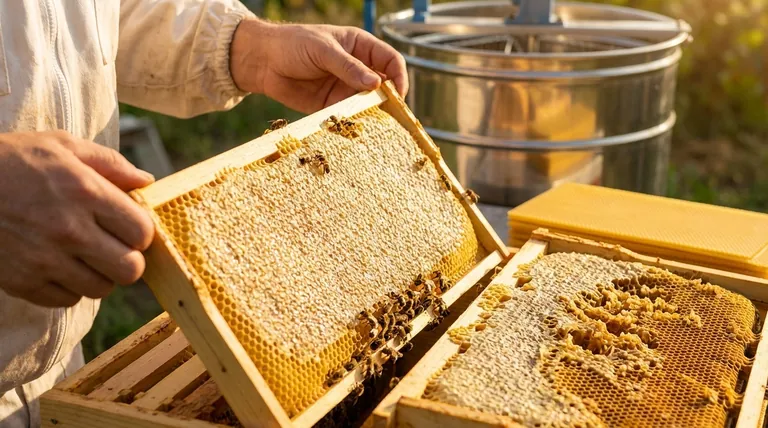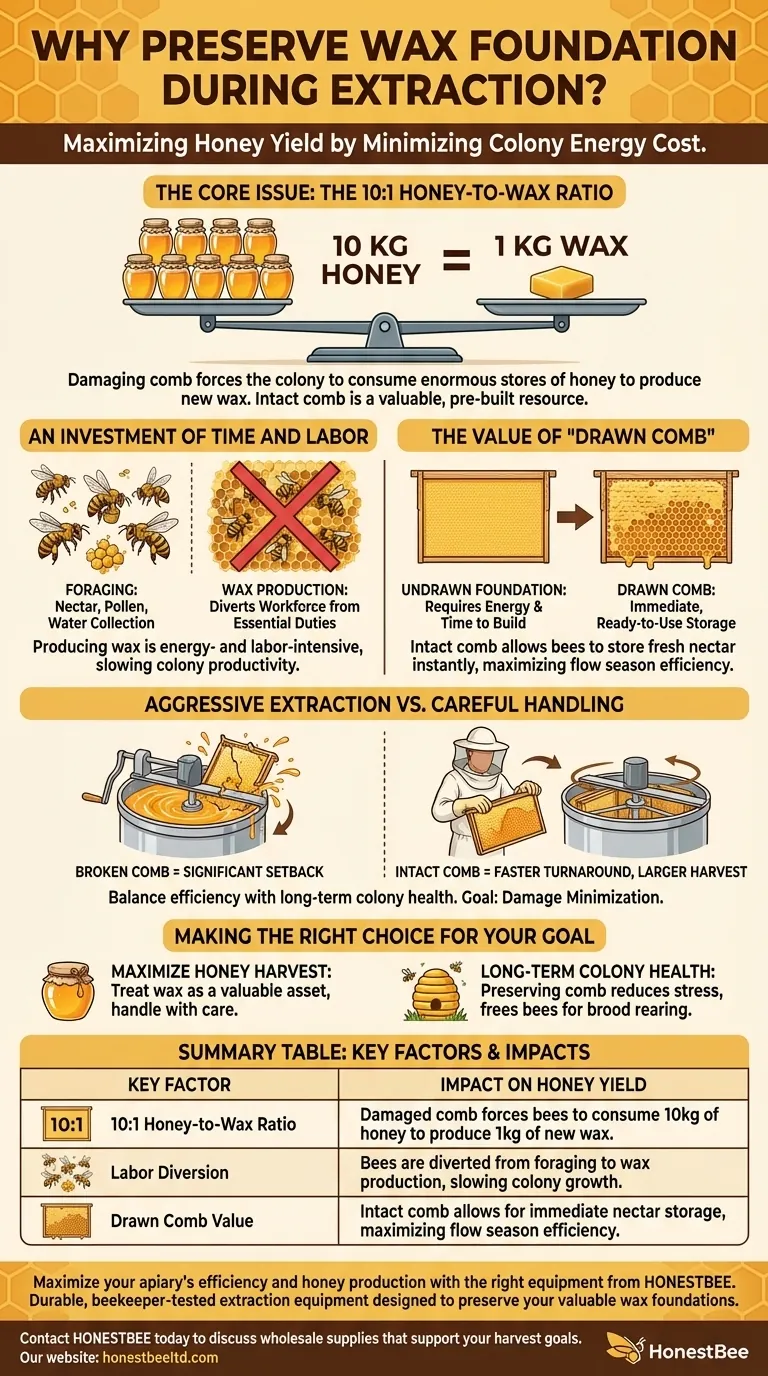Preserving your wax foundation during honey extraction is critical because it directly impacts your total honey yield. Damaging the drawn-out comb forces the colony to consume significant stores of honey to produce new wax, effectively diverting a portion of your potential harvest back into hive maintenance.
The core issue is not the physical damage itself, but the immense energy cost to the colony. Bees must consume roughly 10 kilograms of honey to produce just 1 kilogram of beeswax, making intact comb an incredibly valuable, pre-built resource.

The Hidden Cost of Rebuilding Comb
To fully grasp the importance of preserving wax, you must think of it as the hive's infrastructure. It is a massive energy investment that, once made, pays dividends by allowing the colony to focus on its primary goal: gathering nectar.
The 10:1 Honey-to-Wax Ratio
The most critical principle to understand is the biological cost of wax production. For every unit of beeswax they create, honey bees must consume a massive amount of honey as fuel.
The widely accepted ratio is 10:1 by weight. This means to rebuild 1 kg of damaged wax foundation, the colony must burn through approximately 10 kg of honey that they could have otherwise stored.
An Investment of Time and Labor
Producing wax is not only an energy-intensive task but also a labor-intensive one. It diverts a portion of the workforce from other essential duties.
Instead of foraging for nectar, pollen, and water, these bees must remain in the hive, consuming resources and secreting wax. This slows down the entire colony's productivity and ability to expand.
The Value of "Drawn Comb"
A frame with a fully built-out wax foundation is known as "drawn comb." Giving drawn comb back to the bees after extraction provides them with an immediate, ready-to-use storage solution.
They can begin filling the cells with fresh nectar almost instantly. Forcing them to rebuild from scratch introduces a significant time delay in honey production, especially during a strong nectar flow when time is of the essence.
Understanding the Trade-offs
While perfect preservation is the goal, some practical realities and trade-offs exist in the extraction process. The key is to make informed decisions that balance efficiency with the long-term health of your colony.
Aggressive Extraction vs. Careful Handling
A rushed extraction process—using uncapping tools too aggressively or running the extractor at excessive speeds—might save you time, but it often comes at the cost of "blown-out" or mangled frames.
This damage creates a significant setback for the bees. A slower, more careful approach preserves the comb, ensuring a much faster turnaround for the colony and a larger subsequent honey harvest for you.
When Damage is Unavoidable
Sometimes, damage is inevitable. Old, brittle comb can be particularly fragile and may not withstand the forces of extraction, regardless of your care.
In these cases, the goal is damage minimization. It is better to accept partial damage on a few frames than to adopt careless practices across the board. The principle of conserving the bees' energy remains the priority.
Making the Right Choice for Your Goal
Your approach to extraction should be guided by your primary objective as a beekeeper. Understanding the cost of wax helps you align your actions with your goals.
- If your primary focus is maximizing honey harvest: Treat your wax combs as your most valuable asset. Handle them with care during uncapping and extraction to return them to the hive as close to perfect as possible.
- If your primary focus is long-term colony health: Recognize that preserving comb reduces overall stress on the colony, freeing up the bees' energy and labor to focus on brood rearing and foraging.
By seeing the hive through the lens of energy efficiency, you move from simply keeping bees to managing them strategically.
Summary Table:
| Key Factor | Impact on Honey Yield |
|---|---|
| 10:1 Honey-to-Wax Ratio | Damaged comb forces bees to consume 10kg of honey to produce 1kg of new wax. |
| Labor Diversion | Bees are diverted from foraging to wax production, slowing colony growth. |
| Drawn Comb Value | Intact comb allows for immediate nectar storage, maximizing flow season efficiency. |
Maximize your apiary's efficiency and honey production with the right equipment from HONESTBEE.
As a supplier to commercial apiaries and beekeeping equipment distributors, we understand that your profitability depends on minimizing colony stress and maximizing yield. Our wholesale-focused operations provide durable, beekeeper-tested extraction equipment designed to preserve your valuable wax foundations.
Let us help you protect your colony's energy investment. Contact HONESTBEE today to discuss wholesale supplies that support your harvest goals.
Visual Guide

Related Products
- Beeswax Foundation Sheets Beehive Foundation for Wholesale
- Notebook Style Beeswax Foundation Mould Wax Foundation Mold
- Manual Beeswax Comb Foundation Machine Wax Foundation Mill Embossing Machine
- Electric Beeswax Foundation Machine With Operating Tray and Wax Foundation Roller
- Colorful Silicone Beeswax Foundation Mold Mould for Beekeeping
People Also Ask
- What happens after the flattening and embossing process is complete? From Molten Wax to Solid Foundation
- What is beeswax foundation used for? A Guide to Efficient Hive Management
- How do beeswax foundations save bees time and energy? Boost Hive Productivity & Honey Yield
- What are the sizes of natural worker and drone cells? Guide to Natural Beehive Architecture
- What is 'foundation' in beekeeping, and why is it used? Optimize Hive Management & Honey Production



















